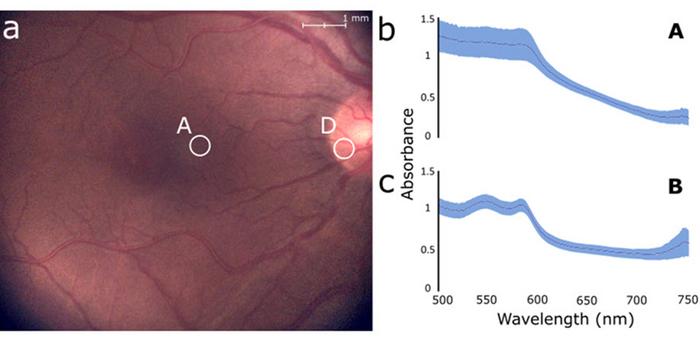News
Article
Study zeroes in on more precise and flexible targeted spectroscopy measurements in the retina
Author(s):
Scientists have developed a versatile imaging system that will help diagnose pathologies in the eye fundus.
(Image Credit: AdobeStock/5AM Images)

A range of ocular diseases include changes to the functions and structure of different regions of the back of the eye, and include fluorescent pigments and tiny yellowish deposits called drusen accumulate under the retina in age-related macular degeneration, and the degeneration of neurons called ganglion cells is a defining characteristic of glaucoma.
These changes in the eye fundus are not limited to vision-related diseases. There are neurological diseases like Parkinson’s and Alzheimer’s that also can result in changes in retinal nerves and blood flow.
Ophthalmologists and other eye care professionals tap color imaging and computed tomography techniques to diagnose ocular diseases. In recent decades, scientists have found that disease-related changes in the eye fundus also modify its profiles for spectral reflectance and emittance. In other words, the way in which light interacts with specific retinal structures at different frequencies can provide important diagnostic information to complement standard imaging methods.
This has led to wider acceptance of spectral analysis tools and techniques for light reflected or emitted by the eye fundus. However, while different methods have been proposed, they still suffer from key limitations. Among the primary issues is the fact that many spectroscopy-based methods can only make measurements over a large region of the eye fundus, which hinders their ability to detect fine spectral changes in small retinal structures. On the other hand, techniques that can make localized spectral measurements require the fixation of the patient, which can be very tedious and uncomfortable.
According to the International Society for Optics and Photonics (SPIE), a research team from Zilia Inc., Canada, led by Dominic Sauvageau, PhD, from University of Alberta, has developed a much more flexible system for targeted spectroscopy in the eye fundus.2
The study,1 recently published in the Journal of Biomedical Optics, offered details of the methods behind their design and demonstrated its potential through a series of experiments.
According to the study, the researchers’ proposal includes some key features that make it stand out as a more versatile and flexible alternative to current options. First, the device has a series of optical elements in essence allow 3 different light paths to and from the eye fundus to coexist without hampering each other. Moreover, illumination LEDs, a color camera, and a spectrometer can be used jointly to provide continuous color imaging and spectral measurements.1
The proposed system can take detailed images of the eye fundus in real time while simultaneously measuring the spectral profile of a small target region, whose position can be readjusted easily without requiring patient fixation. These capabilities make it easier to observe the spectral properties of specific structures or lesions in the retina, which can help in the diagnosis of various conditions. (Image courtesy of Lapointe et al.),

The study also found that the spectrometer section of the device focuses an LED onto a small region of the eye fundus, and the position of this region can be adjusted using simple mechanical actuators to rotate the beam splitter feeding the camera and the spectrometer.
“The user can select a target and move it to any location within the eye fundus region being imaged without any realignment or change of the fixation target while continuously receiving spectral information of the targeted sampled area,” Sauvageau said in the SPIE news release.
According to the SPIE news release, the feature makes it easy to take spectral measurements from very specific anatomical structures, such as the optic nerve, the retina, leakage of blood, or fat deposits, or any type of lesion. Notably, the system can also be used to conduct fluorescence measurements by adjusting the illumination source, which extends its applicability to detect an even wider variety of biomarkers.2
The news release further noted the researcher used both in vitro and in vivo experiments to confirm the performance and capabilities of the system.
The in vitro experiments involved targeting colored areas in a reference target with a grid-like pattern and taking spectral measurements of an eye model that simulated a macula, blood vessels, a foreign body, and the optic nerve. They noted the in vivo measurements were performed on the retinas of eight healthy subjects, which exhibited differences in the spectral profiles of the optic nerve and the parafoveal region.2
It is maintained the study’s results point to the potential advantages of the proposed design and could pave the way to better diagnostic protocols for eye diseases.
“Targeted ocular spectroscopy has the potential to assess the presence of different chromophores and fluorophores, such as hemoglobin, oxyhemoglobin, melanin, and lipofuscin, associated with disease progression,” Sauvageau concluded in the news release. “This could open the door to changes in the way we diagnose and treat eye diseases, and targeted ocular spectroscopy could become an increasingly important tool in eye care in the coming years.”
Reference:
1. Nicholas Lapointe; Cléophace Akitegetse; Jasmine Poirier; Maxime Picard; Patrick Sauvageau; Dominic Sauvageau. Targeted spectroscopy in the eye fundus. J. Biomed. Opt. 28(12), 126004 (2023), doi 10.1117/1.JBO.28.12.126004.
2. Toward more precise and flexible targeted spectroscopy measurements in the retina. EurekAlert! Accessed December 18, 2023. https://www.eurekalert.org/news-releases/1011454
Newsletter
Don’t miss out—get Ophthalmology Times updates on the latest clinical advancements and expert interviews, straight to your inbox.





